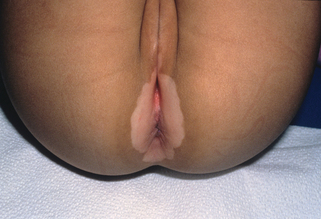Chapter 61 Disorders of the female genitalia
Nonneoplastic epithelial disorders of the vulva
1. What is lichen sclerosus (also known as lichen sclerosus et atrophicus)?
Lichen sclerosus (LS) (Fig. 61-1) is an inflammatory condition that primarily affects the superficial dermis. The disease process results in thinned or atrophic white papules and plaques of the skin. LS primarily affects the anogenital region, but it can also present on the trunk or extremities. Lichen sclerosus of the vulva most commonly affects postmenopausal women, but it can also develop in 7% to 15% of prepubertal females.
2. Describe the clinical signs of lichen sclerosus of the vulva.
The characteristic findings associated with lichen sclerosus include white, thinned, crinkled skin (it is frequently described as “cigarette paper” atrophy). Often there are areas of ecchymoses in the involved skin. The majority of the vagina is usually unaffected; however, a patient may have involvement of the vaginal introitus, leading to stenosis. One also may find fusion of the labia minora, phimosis of the clitoral hood, and fissures. LS can also simultaneously involve the perianal area, which then forms a “figure-of-eight” pattern.
Val I, Almeida G: An overview of lichen sclerosus, Clin Obstet Gynecol 48(4):808–817, 2005.
4. Is there a need to biopsy lichen sclerosus of the vulva?
Yes. Biopsy of the affected site can aid in differentiating lichen sclerosus from other disorders, such as vitiligo (Fig. 61-2) and lichen planus. Hyperkeratotic, ulcerated, or nodular lesions should be sampled to rule out vulvar intraepithelial neoplasia (VIN) or squamous cell carcinoma of the vulva. The risk of LS becoming malignant is 4% to 6%.
5. How does one treat lichen sclerosus?
The most widely accepted first-line treatment is use of a high-potency topical corticosteroid, most commonly clobetasol proprionate. Other less common therapies used for recalcitrant LS include intralesional corticosteroids, retinoids, oral potassium para-aminobenzoate, chloroquine, tacrolimus/pimecrolimus, cyclosporine, and photodynamic therapy with topical 5-aminolevulinic acid. LS in children often will resolve at the time of puberty.


Figure 61-2. Vitiligo showing characteristic total depigmentation with evidence of atrophy. Notice the typical scalloped margins.
(Courtesy of Fitzsimons Army Medical Center teaching files.)
8. Are there different variants of lichen planus that affect the vulva?
Yes. Variants that affect the vulva include erosive lichen planus, papulosquamous lichen planus, and hypertrophic lichen planus. The most common variant found in the vulva is erosive lichen planus. This variant is characterized by erosions on a background of violaceous papules and plaques. The skin of the vulva may also appear shiny, reticulated and white. Rarely, oral-vulval-vaginal lichen planus may also be seen. Of the approximate 1% of the population with oral lichen planus, 25% have vulvovaginal disease.
9. What are the clinical symptoms of vulval lichen planus?
Patients most commonly present with complaints of vulvovaginal burning, pruritus, postcoital bleeding, and dyspareunia. Up to 70% of patients also have vaginal lesions. There may be an associated purulent vaginal discharge and chronic erosions of the vaginal epithelium can lead to the development of extensive adhesions leading to vaginal narrowing and obliteration.
Lewis FM: Vulval lichen planus, Br J Dermatol 138(4):569–575, 1998.
11. How do you treat lichen planus of the vulva?
Stay updated, free articles. Join our Telegram channel

Full access? Get Clinical Tree









